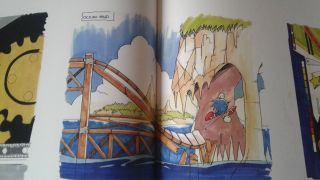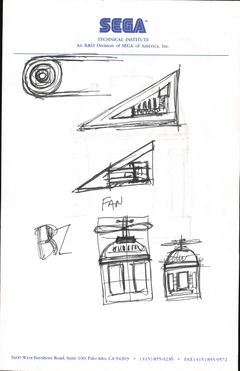Prerelease:Sonic the Hedgehog 2 (Genesis)/Scrapped Zones
This is a sub-page of Prerelease:Sonic the Hedgehog 2 (Genesis)/Scrapped Zones.
Sonic 2 is infamous for how many stages were cut from the final release, ranging from well known to name-only.
Contents
Ocean Wind Zone
What was meant to be the second stage in the game after Emerald Hill Zone and would've been a coastal area with piers and rock structures in the background; concept art of the stage by Yasushi Yamaguchi (credited as Judy Totoya) was released as part of the Sonic the Hedgehog 25th Anniversary Art Book. Emerald Coast from Sonic Adventure has a similar concept and design.
According to concept art, Ocean Wind would've occupied slot $01 in the level index, which is unused in all prototypes and the final game.
Wood/Secret Jungle Zone
Another relatively well-known scrapped stage, Wood Zone was to be a dense jungle with Sonic running into various trees. Wood Zone was partially implemented in the Simon Wai and August 21st builds of the game, albeit incomplete and without objects. Concept art of the present shows that its original title was Woods Zone.
Interestingly, concept art shows another stage similar to Wood called Secret Jungle, but this time would've feature spring branches to guide Sonic up; it's unknown if Secret Jungle was its own stage, or just an earlier idea for Wood Zone. Given that the concept art was made extremely early in the game's development, it's most likely the latter.
In all prototypes starting with the Simon Wai build, Wood Zone occupies slot $02.
Sand Shower/Winter Zone
Sand Shower Zone is the name given to a level which, if it was implemented, could have been the first desert level in a Sonic game. Only one image of this zone exists (which was later revealed to have been a mock-up), and shows a Gator badnik - whose sprites only appear in the Nick Arcade and Simon Wai prototypes - as one of the enemies, although it is unknown whether the Gator was intended to appear in that zone, due to the image's status as a mock-up. A layout for Sand Shower was completed before the zone's removal, and featured both above and underground sections. However, said layout was never programmed into the game before being scrapped.
While Sand Shower Zone was being made, the development team worked on plans for another level tentatively called Winter Zone. It would have been Sand Shower but with a winter theme given to the zone's graphics, changing the palette and replacing cacti with Christmas trees. An idea thrown around before the idea of Winter Zone was that Sand Shower would, halfway through the act, transform into a snow-themed level.
Eventually, the entire zone was scrapped entirely. However, both the concept and design would resurface some twenty years later in the remastered Sonic CD as Desert Dazzle, which would also end up scrapped, and eventually, in Sonic Mania as Mirage Saloon Zone.
According to concept art which matches up closely with the internal stage order, Sand Shower would've occupied slot $03, which was used for Emerald Hill Zone in the Nick Arcade prototype, but unused for all other prototypes and the final.
Interestingly, before the release of the prototypes and design documents, the name Dust Hill was often used in Sonic communities to refer to Sand Shower Zone rather than Mystic Cave. The origin for the name mix-up is unknown.
Tropical Plant/Tropical Sun Zone
A rather unknown stage with only concept art available (under the name Tropical Sun), and that it would've occupied slot $05 and preceded Hill Top Zone. $05 is used for Metropolis Zone Act 3 in all builds, suggesting it never got past the concept stage.
Blue Lake/Blue Ocean Zone
Another rather unknown stage with only concept art available, titled Blue Ocean before being changed to Blue Lake. According to concept art, it would've occupied slot $06, which is used for Wing Fortress starting with the September 14th prototype.
Madness Mountain Zone
Another rather unknown stage with only concept art available, titled Madness Mountain.
Emerald Isle
A scrapped stage similiar to Aquatic Ruin Zone. It is unknown if this was an early name for the level.
Olympus Zone
One of the most unknown stages with the only proof of its existence, being in the form of a early map of the game.
The Last Battle in Space
It appears that Death egg Zone was supposed to be a full zone with levels outside in space. It occupied slot $10 in the concept art. Slot $10 is occupied by Sky Chase in the final build.
Hidden Palace Zone
The big daddy of cut content in Sonic games, Hidden Palace Zone started out as one of the first zones developed for Sonic 2, along with Emerald Hill, Hill Top, and Chemical Plant. The original plan for Hidden Palace was that Sonic, after collecting all of the Chaos Emeralds, would warp to the zone, where he would learn how to become Super Sonic. After being cut down from two acts to one, Hidden Palace Zone was removed due to time constraints and the idea of Sonic going to a zone to learn how to become Super was scrapped. Hidden Palace was primarily removed due to time constraints, though Christian Whitehead (who developed the 2013 iOS and Android remake) revealed in 2015 that Sonic Team told him that quality concerns also played a role in its demise. The removal of Hidden Palace Zone was a last-minute decision; music, a title card and a level select icon were created for the zone, and still exist in the final game's data. This icon can be seen in Sonic 3's level select by scrolling over to the second 2P VS option.
Some of the zone's art was reused for future Sonic games - the glowing bridges and spheres made an appearance in IceCap Zone in Sonic the Hedgehog 3, and the design of Hidden Palace was used as the basis for Toxic Caves in Sonic Spinball. The name of the zone itself would be given to a similar-themed (but otherwise unrelated) level in Sonic and Knuckles. A finished version of Hidden Palace Zone was added in the 2013 iOS and Android port as a secret level. There's even a level that includes the same assets with a radically different layout for an unreleased game Segapede (or Astropede).
In addition to this, there exists an early mockup of Hidden Palace Zone which has a different, more realistic cave background. In the distance are barely noticeable stalagmites, the graphics of which appear in the data of the Nick Arcade and Simon Wai prototypes:
In the Nick Arcade prototype, it occupied slot $04 before being changed to slot $08 in all other prototypes and the final.
Rock World Zone
As mentioned above, Rock World Zone was planned as the "past" version of Sand Shower Zone, when Sonic 2 was going to be about time travel. Once the time travel concept was scrapped, Rock World Zone went with it.
Since this happened early in Sonic 2's development, Rock World Zone is easily the least complete of the known scrapped zones; it doesn't have sprites or a layout. The only piece of concept art that refers to it is an unused badnik called Banper (most likely supposed to be "Bumper"), which would have used its bumpers to push Sonic away.
According to concept art of the early map, it would've occupied slot $09, which is unused in all versions of Sonic 2.
Genocide City/Cyber City Zone
Planned to be a single-stage zone, Cyber City Zone was a mechanical themed stage that originally had the name of Genocide City. Once Cyber City was scrapped, the layout of the zone was improved on and reused as a third act for Metropolis Zone. Some of the graphical art created for Cyber City would be repurposed for The Machine in Sonic Spinball, in the same fashion that Hidden Palace Zone art was used for Toxic Caves. Its intended slot, $0E, was used for Death Egg starting with the September 14th prototype.
Genocide City can be selected in the level select of the Simon Wai prototype of Sonic 2, but the acts themselves are empty.
The chunk layout and concept art seen on the right demonstrate various gimmicks that Genocide/Cyber City Zone would have contained, including fans, a green vertical "elevator", midair conveyor belts similar to those seen in Metropolis Zone, and what seem to be conveyor belts lined up on walls and ceilings.
Some more concept art of Cyber City shows that some graphics would have been variations of Metropolis Zone's tiles with a more futuristic look. It also shows the alternate, less dangerous rename the zone was given.
















